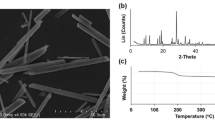Synopsis
Crystals of calcium oxalate in pathological material and artificially precipitated in the absence or presence of citric acid in gelatin models were examined by polarized light and treated with silver nitrate under a variety of conditions. It was found that the intensity of the staining reaction was largely proportional to the strength of the silver solution, and was enhanced inin vitro studies by the presence of citric acid. Staining was also influenced by the crystal form, which was itself related to the absence or presence of citric acid.
Similar content being viewed by others
References
Barka, T. &Anderson, P. J. (1963).Histochemistry. New York: Hoeber.
Bills, C. E., Eisenberg, H. &Pallante, S. L. (1971). Complexes of organic acids with calcium phosphate: The von Kossa stain as a clue to the composition of bone mineral.Johns Hopkins Med. J. 128, 194–207.
Cameron, G. R. (1930). The staining of calcium.J. Path. Bact. 33, 929–55.
Chaplin, A. J. (1974). Some observations on the demonstration of calcium oxalate in tissue sections.Stain Technol. 49, 165–73.
Chaplin, A. J. (1975). Calcium pyrophosphate. Histological characterisation of crystals in pseudogout.Arch. Path. in press.
Gogan, D. G., Hurlbut, C. S. &Toichiro, K. (1958). Crystalline calcium sulphate (gypsum) in scleal plaques of a human eye.J. Histochem. Cytochem. 6, 142–5
Culling, C. F. A. (1974).Handbook of Histopathological Techniques, 3rd Edn. London: Butterworths.
Foesch, M. (1985). Bemerkungen zur Kritik der Tinctions—Präparate.Z. wiss. Mikrosk. 2, 464–77.
Gomori, G. (1952).Microscopic Histochemistry, Chicago: University of Chicago Press.
Klotz, O. (1905).J. expr. Med. 7, 633. Cited byCameron (1930).
Lewis, R. D., Lowenstam, H. A. &Rossman, G. R. (1974). Oxalate nephrosis and crystalline myocarditis.Arch. Path. 98, 149–55.
Lillie, R. D. (1965).Histopathological Technic and Practical Histochemistry, 3rd Edn. New York: McGraw-Hill.
Lonsdale, K. (1968). Epitaxy as a growth factor in urinary calculi and gall stones.Nature 217, 56–8.
Macallum, A. B. (1905). On the distribution of potassium in animal and vegetable cells.J. Physiol. 32, 95–128.
Mcgee-Russell, S. M. (1958). Histochemical methods for calcium.J. Histochem. Cytochem. 6, 22–42.
Mcmanus, J. F. A. &Mowry, R. W. (1960).Staining Methods. Histologic and Histochemical. New York: Harper and Row.
Meloan, S. N., Puchtler, H. &Valentine, L. S. (1972). Alkaline and Acid Alizarin Red S stains.Arch. Path. 93, 190–7.
Pearse, A. G. E. (1972).Histochemistry, Theoretical and Applied. Vol. II, 3rd Edn, London: Churchill.
Pizzolato, P. (1964). Histochemical recognition of calcium oxalate.J. Histochem. Cytochem. 12, 333–6.
Pizzolato, P. (1971). Mercurous nitrate as a histochemical reagent for calcium phosphate in bone and pathological calcification and for calcium oxalate.Histochem. J. 3, 463–9.
Pizzolato, P. &Mccrory, P. (1962). Light influence on von Kossa's silver nitrate calcium reaction in the myocardium.J. Histochem. Cytochem. 10, 102.
Schuscik, O. (1920). Über die Methoden zum Mikroskopischen Nachweis von Kalke im ossifizierenden Skelett.Z. wiss Mikrosk 37, 215–32.
Thunberg, T. (1953). Occurrence and significance of citric acid in the animal organism.Physiol. Rev. 33, 1–12.
Thompson, S. W. &Hunt, R. D. (1966).Selected Histochemical and Histopathological Methods. Springfield. Thomas.
Von Kossa, J. (1901). Über die im Organismus künstlich Verkalkungen.Beitr. Path. Anat. 29, 163–202.
Von Recklinghausen, F. (1862).Die lymphgefässe und ihre Beziehung zum Bindegewebe. Berlin: Hirschwald.
Yasue, T. (1969). Histochemical identification of calcium oxalate.Acta histochem. cytochem..2, 83–95.
Author information
Authors and Affiliations
Rights and permissions
About this article
Cite this article
Chaplin, A.J., Grace, S.R. Calcium oxalate and the von Kossa method with reference to the influence of citric acid. Histochem J 7, 451–458 (1975). https://doi.org/10.1007/BF01003882
Received:
Issue Date:
DOI: https://doi.org/10.1007/BF01003882




